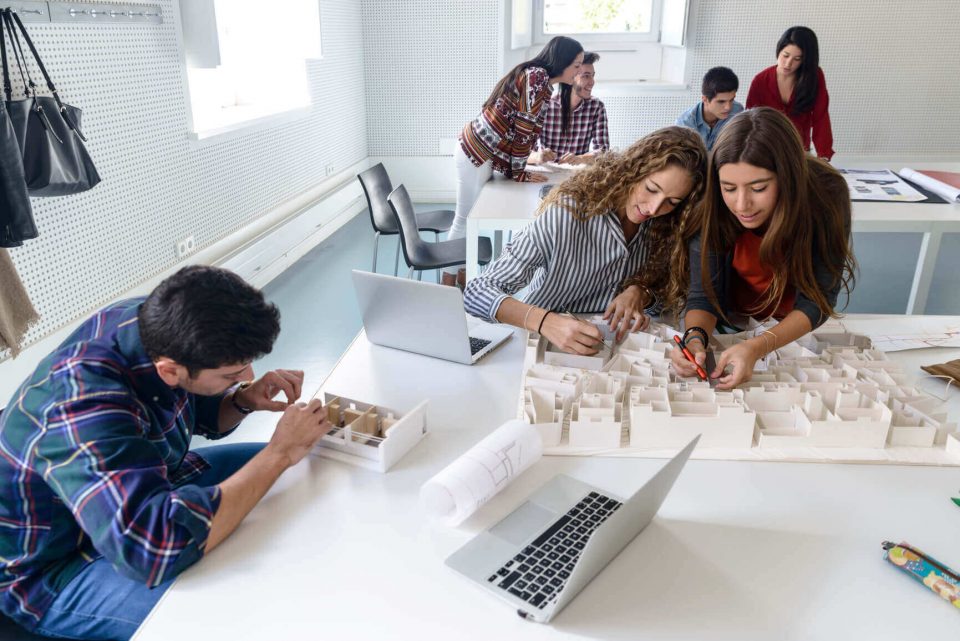10 Skills Needed for a Career in Interior Design
You might think a good interior designer is someone who’s artistic and detail-oriented, who understands the principles of balance and harmony, color theory, and has spatial awareness. You wouldn’t be wrong–but you wouldn’t be entirely right, either.
“People who are both right and left-brained–creative and logical–do well [in interior design],” according to Britta Bielak. But if you really want a successful interior design career, you should start focusing on your soft skills.
A full-time faculty member at Design Institute of San Diego, Bielak started her career as an artist and after graduate school transitioned to interior design while working as a project manager for commercial architecture firms. She says that the hard skills of design are things you can learn in an interior design program. In fact, there are even options for remote degrees with interior design programs online.
“You don’t have to have an art background or a design background to pursue a career in interior design. It’s fine if you’ve never drawn or used a scale before. You may have always felt like a creative person, but never practiced being creative. We teach you those things.” But to make those hard skills really flourish, you’ll need to hone these 10 skills for a career in interior design.
10 Skills Needed for a Career in Interior Design
1. Being an excellent listener
It’s so important to listen without expectation, Bielak advises. Being an excellent listener means really listening to your clients, even if you think you know what they’re going to say. When asked what they do, many designers will say they problem-solve: they listen to clients to find the ways an interior space can work better for the people who use it. Art and design both draw from the same well of inspiration. Interior designers tap into that source to make people’s environments – and their lives – better. Skillful listening also means you should be able to reiterate back in your own words what you’ve heard to reassure clients you were listening, and to give them the opportunity to clarify if something they said wasn’t exactly what they meant. Speaking of communication…
2. Being a good communicator
Bielak notes that one of the ways to advance your career as an interior designer is to become a project manager, which means you need to develop really strong communication skills. As a project manager, you’ll have to communicate not only with your clients, but also with a team of architects, designers, engineers, vendors, and more, depending on the project. Can you craft a really good email? Can you clearly and succinctly communicate project needs, timelines, feedback on design plans, and expectations?
Another way to advance your career in interior design is to follow the “designer path” – first as a project designer and then as a senior interior designer. Skillful designers cultivate a fluency in design styles that comes with an understanding of origins in global cultures, or they may transcend style with contemporary solutions based in function. Honing the ability to communicate well is critical to growing in your career whether working for a firm or for yourself.
3. Being both detail-oriented, and big-picture
A good interior designer can focus on the details, but also be able to assess the big picture at the same time. “This isn’t interior decorating; it’s not just about the furnishings. It’s really about being able to build and shape space, and also select the finishes, materials, colors, and furnishings,” says Bielak.
Knowing how to manage the space between pieces of furniture in a single room is important, but you should also be able to think about how the furniture relates to the size of the room, or even how that room relates to the other rooms in a house. Computer-aided design helps the designer manage those relationships between spaces. The latest CAD software is intuitive and builds skills while you are creating. You can draw plans and render them in 3D, selecting styles ranging from realistic to artistic. You can even create “fly-throughs” that present the client a room-to-room sequence of the experience before it is built.

4. Learning to think 5 steps ahead
An interior designer should not only understand the design implications of the pieces they’re considering in a space, they should also be able to anticipate the impact those choices could have when you move from one material or space to the next. The same goes for managing a project. Can you anticipate the downstream effects on your team or the project of the decisions you make? Shortsightedness will not serve you well in interior design.
5. Being able to admit you’ve made a mistake
“It feels awful to make a mistake,” Britta admits. “But that makes it easy to learn from.” When things go wrong and people start to point fingers, that can dissolve the trust on a team, and even erode trust with your clients. Admitting mistakes maintains both the integrity of your team and the business.
6. Learning not to take feedback too personally
“Art is incredibly personal, and it can be incredibly difficult to not take feedback or criticism personally.” Bielak knows this feeling well as both an artist and interior designer. “Just remember that a collection of diverse perspectives and input often create the best projects.” You don’t always have to take the feedback, but it should teach you something or give you another perspective you can take to another project.
7. Knowing yourself
This is more than knowing whether you’re an introvert or extrovert, or whether you want to work in small design firms or larger firms. It’s also about knowing your values.
Is sustainability important to you? Are you concerned about designing in a way that’s culturally sensitive? Do you only want to use vegan or cruelty-free materials? Know your values so you can carve a career path that aligns with those values.
8. Getting really comfortable with the code
Interior design isn’t just about assembling and decorating with beautiful things. Interior designers have to follow building and accessibility codes for the health and safety of people inhabiting the spaces they work with. You’ll need to know the codes, or at least know where to look. Bielak says it’s normal for this part to feel really intimidating when you’re starting out, but empowering yourself with that knowledge is important.
9. Having excitement for iteration
Translation: Get comfortable with doing things more than once. Especially if you’re a perfectionist, it’ll take the pressure off of feeling like you have to get things perfectly your first go-around. Be comfortable, and find joy in experimenting.
10. Cultivating your curiosity
Be curious and open to trying new things. “It’s a big mistake for designers to only look at interior design to enrich their interior design experience,” Bielak says. “Bring in inspiration from other fields or areas that you care about. For example, if you love spending time in nature or If you’ve worked in restaurants you can bring that first-hand experience into what you’re learning about in design.” Use your curiosity to bring innovation and creativity to your process.

These 10 skills provide a glimpse of the interior designer’s experience. You may see yourself in many of them and want to know how you can improve in others.
“It’s okay if you struggle with some of these things,” Bielak says. “This goes back to knowing yourself. If you struggle with the bigger picture but love just being zoomed in on the details, maybe that means you could go into product design. If you notice you get excited when we’re talking about pattern and color, but zone out when we’re talking about space, maybe you go into textiles later.” There are innumerable ways you can channel what you are good at into a successful interior design career.
Experience the Profession First-Hand
The interior design programs at Design Institute of San Diego will expose you to a faculty of practicing interior designers from day one – and let you experience the profession first-hand as an “extern” at an interior design firm. With a Bachelor of Fine Arts (BFA) in Interior Design Degree Program and a Master of Interior Design (MID) in two and three-year tracks, a degree from Design Institute of San Diego will prepare you to pursue interior design jobs. Learn more about how to have a successful career in interior design today.
By: Britta Bielak, NCIDQ
Full-time Faculty